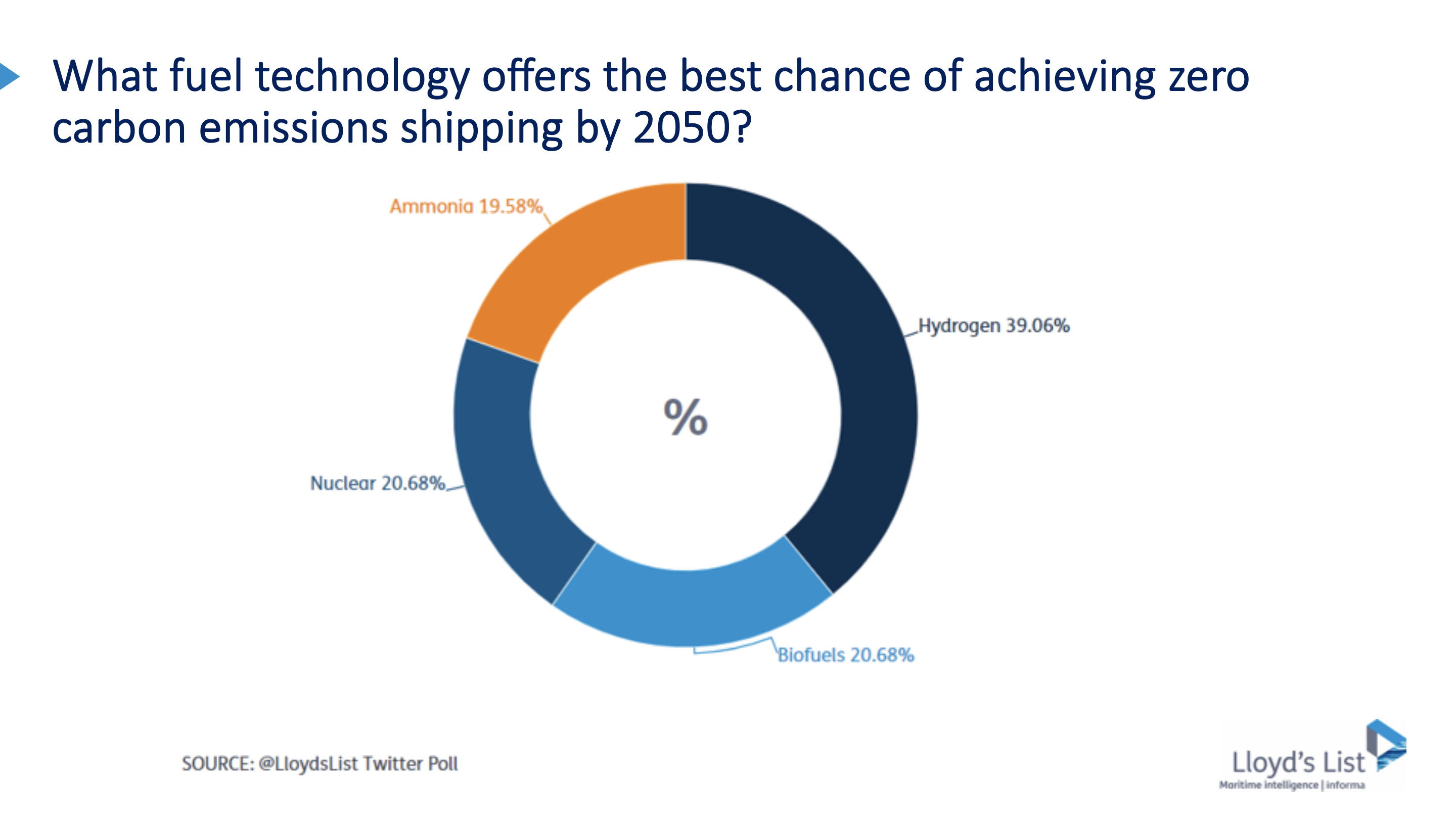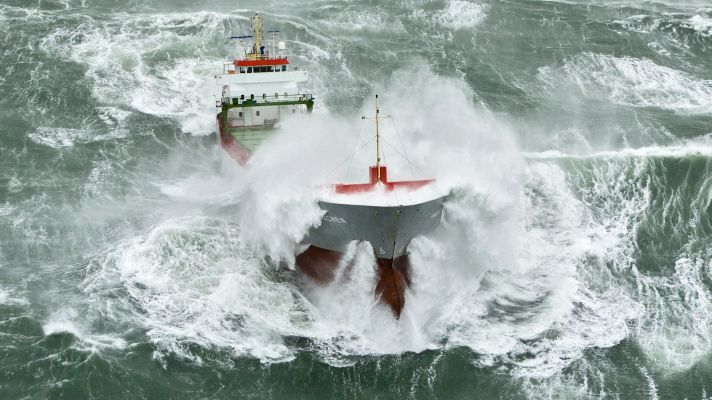‘The people are the backbone of the industry and their talent will drive shipping forward’ is just one of the conclusions of Lloyd’s List’s 2021 Shipping Outlook Forum. When it comes to fuels, hydrogen is still a prime candidate, but nuclear power is also considered a viable option.
Lloyd’s List’s 2021 Shipping Outlook Forum took place online on Tuesday 2 December and involved a panel of shipping experts led by Lloyd’s List Managing Editor Richard Meade. Through a number of questions, the participants were asked to present their views on issues such as the crew changeover crisis, investment opportunities, threats and future fuels.
How much has the crew change crisis altered the perception of the shipping industry?
Meade: ‘We witnessed a humanitarian crisis at sea this year, with 100,000s crew stranded on vessels. Everyone from the pope to the Secretary General of the IMO has tried to raise the profile of this situation. When even divine intervention fails to raise, I’d say we have a fundamental flaw in the way that our industry represents itself.’
Still, Mark O’Neil, President and CEO of Columbia Shipmanagement, says there is a lot we can takeaway from this crisis. ‘One thing that Covid has done, is that it has really focused us on better identifying with our crew and their needs. It broke my heart that some of our crew said in a survey that they felt part of an invisible sector, an invisible workforce. And that sums it up. Covid-19 has brought many of these issues that shipping has been sweeping under the carpet to the fore. We have to better identify with our crew, communicate with our crew, better provide for our crew with WiFi, with benefits, with pension and disability provision, medical health cover, and mental health support. They need to feel supported.’
It broke my heart that some of our crew said in a survey that they felt part of an invisible sector, an invisible workforce
As a result he expects the industry will come out of Covid-19 focusing on what is really important: ‘our people. Too much have we been focusing on technology and digitalisation. Of course these are massively important to our industries, but they are the tail and not the dog. Before the Covid-19 crisis, the tail was wagging the dog, but now we have put the priority back firmly on our people.’
What is the best investment opportunity for shipping in 2021?
‘The green transition is the investment of the decade or even of the century,’ says Johannah Christensen, Managing Director of the Global Maritime Forum. ‘I hope to see a quantum leap in decarbonisation over the coming year.’
‘When we look at the big challenges on our agenda, whether it is digitalisation or decarbonisation, we’ve got to invest in our people,’ adds Nick Brown, Marine & Offshore Director at Lloyd’s Register. ‘We are going to need to enhance the skills and expertise of the people within our industry and we are going to need to bring in additional skills and expertise. If we ignore the fact that the people are the backbone of the industry and that their talent will drive this industry forward, then I think those transformations will be delayed.’
‘Great acceleration of change in this industry is underway’
When asked whether we should focus on the current efficiency of the current fleet or get zero carbon RD up and running now, Michael Parker, Chairman of Global Shipping, Logistics and Offshore at Citi says that: ‘Obviously, we need to focus on both, but the last thing we need is additional ships. We do need investments in the new technologies. And we can see this going on in hydrogen and ammonia for example.’
Accelerated by Covid or not, collaboration has increased
He adds: ‘But the industry has to become profitable, and we don’t talk about that enough in shipping. That is why additional capacities are needed, because the industry has to invest in itself and the cargo owners have to be part of this. Accelerated by Covid or not, collaboration has increased. We have lost physical networking aspect, but we made much more progress intellectually. We should focus not just on decarbonisation, but on the importance of the shipping industry to the global economy in its broadest sense, which is decarbonisation, but it also the health of its workforce, the seafarer issue and safety.’
‘It’s a great opportunity for shipping to come together and get things done in say five years that would normally take 25 to fifty years. The great acceleration of change in this industry is underway.’
Speaking from the financial community, Parker sees limited new capital is coming in. ‘I think the institutional capital this industry needs, will come with the transition, will come with a combination of the institutional financing of infrastructure and the distribution of new fuels that benefit shipping and that shipping will be part of. This will act as a catalyst. Digitalisation, retrofitting and zero-carbon fuels are not going to happen overnight. The keyword is making the transition active both through the investment in the industry, but also visible to the consumer and the politicians.’
What is the greatest threat to shipping over the next five years?
O’Neil says volatility and a lack of uniformity are ‘a dangerous mix’ and pose the biggest threat to shipping. When it comes to volatility, the industry is very unsure of what vessel or fuel type to go for. So this is always a threat, according to O’Neil.
‘As an industry, although quite small when looking at the number of seafarers, we fail remarkably to speak with one voice and to adopt best practices from colleagues and competitors,’ adds O’Neil. ‘In airlines for example, there is much more uniformity. We need to try to speak more with one voice at the various lobbying forums. So that this industry can try to move forward in a more concerted fashion.’
Lack of uniformity and volatility is a dangerous mix.
Brown sides with O’Neil, but says that uncertainty and volatility are something ‘we have to get used to’ as ‘we are moving from what today basically is a single-fuel industry to a multi-fuel future. And I don’t believe we are going to get the winner of the alternative fuels within the next ten years.’
Henderson goes on to say that he thinks the biggest risk is to do nothing on lowering emissions. ‘There are a lot of groups, meetings and such, but very little practical delivery. So what we need to do is turn that discussion and debate into real delivery and actions in the industry. That includes energy efficient technologies, putting in place solutions around LNG as a fuel (which would make it easy to get to minus forty/sixty per cent emissions reductions against the IMO 2008 baseline). So it is important that we move forward and make some of these changes around lowering emissions at the same time as developing the new fuels such as hydrogen, et cetera.’
Christensen adds that regulatory frameworks are needed ‘to kickstart investments, both into energy efficiency and the zero emission future’. She continues: ‘Shipping plays a key role in proactively engaging in that process instead of sitting back and waiting for things to happen. No industry is an island. There is a need for collaboration. Many challenges (decarbonisation, crew changes, digitalisation) require collaboration across the sector and beyond with other stakeholders and industries. Transparency will play a large role in this.’
The biggest threat is taking our foot of the pedal after Covid
Tangible solutions can boost the transitions shipping faces. Parker points to the live-streaming of emissions that is to become available some time next year, not just in shipping but across the supply chain. ‘Every company that commits to zero emission, will only want to do business with a company that commits to this as well. That is the benefit of the emissions data. This is an example of where shipping is leading the way. We’ll be setting an example for many other industries to follow.’
The biggest threat, according to Parker is ‘taking our foot of the pedal after Covid, we have got to keep the pressure up.’
Meade concludes this topic by saying that ‘mandatory regulation, financial incentives, and proven demand from customers will all be needed to accelerate the decarbonisation process. This is not there in sufficient quantity yet to make fast decisions.’
Nuclear back on the agenda
When asking what the best chance is of achieving zero carbon emissions by 2050, Meade says this is ‘the big one, we are in the betting zone here’. He shows a graph based on a Lloyd’s List Twitter poll in which people were asked which of four fuel technologies offers the best chance of achieving zero-emission shipping by 2050 (see below). 39.06 per cent voted for hydrogen, with nuclear and biofuels coming in second (both 20.68 per cent) and ammonia finishing last with 19.58 per cent.

Henderson seems quite certain of the answer to this question. He says hydrogen is the most likely zero-emission fuel for shipping, with fuel cells. ‘The reason for this is that it is being developed for other industrial sectors, such as for airplanes, buses and trains. This will mean that the hydrogen is being provided by other sectors, avoiding shipping will have to shoulder all of the costs. So it is very important we move with the other sectors in this.’
Brown takes a more nuanced view: ‘The real technology actually comes from green electrons. The cheaper we can make those electrons, as long as they’re green, then as an industry we can apply whichever fuel suits the trade of the vessel. I agree that there’s gonna be possible solutions at least around hydrogen, ammonia and nuclear, if nuclear is going to be acceptable to society. Hydrogen, particularly with batteries, is going to be a really interesting solution for short sea shipping, but may be less suitable for deepsea operations due to its energy density.’
Yet, there may be other options too. O’Neil says the environment argument is ‘moving at such a pace, that in a few years’ time, electricity itself may be considered unsustainable, because of the manufacturing process and the disposal of batteries and their components. It may well be that traditional carbon fuels burnt in a much more environmentally friendly way prove to be the most environmental. There is a whole palet of fuels open to us, all of those fuels being used in an environmentally friendly way. I don’t think there will be any firm siding with any one particular fuel source.’








